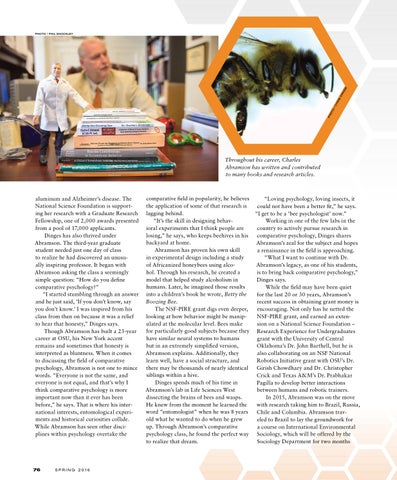PH
OT
O
/C H
RI
S
DI
NG
ES
PHOTO / PHIL SHOCKLEY
Throughout his career, Charles Abramson has written and contributed to many books and research articles.
aluminum and Alzheimer’s disease. The National Science Foundation is supporting her research with a Graduate Research Fellowship, one of 2,000 awards presented from a pool of 17,000 applicants. Dinges has also thrived under Abramson. The third-year graduate student needed just one day of class to realize he had discovered an unusually inspiring professor. It began with Abramson asking the class a seemingly simple question: “How do you define comparative psychology?” “I started stumbling through an answer and he just said, ‘If you don’t know, say you don’t know.’ I was inspired from his class from then on because it was a relief to hear that honesty,” Dinges says. Though Abramson has built a 23-year career at OSU, his New York accent remains and sometimes that honesty is interpreted as bluntness. When it comes to discussing the field of comparative psychology, Abramson is not one to mince words. “Everyone is not the same, and everyone is not equal, and that’s why I think comparative psychology is more important now than it ever has been before,” he says. That is where his international interests, entomological experiments and historical curiosities collide. While Abramson has seen other disciplines within psychology overtake the
76
SPRING 2016
comparative field in popularity, he believes the application of some of that research is lagging behind. “It’s the skill in designing behavioral experiments that I think people are losing,” he says, who keeps beehives in his backyard at home. Abramson has proven his own skill in experimental design including a study of Africanized honeybees using alcohol. Through his research, he created a model that helped study alcoholism in humans. Later, he imagined those results into a children’s book he wrote, Betty the Boozing Bee. The NSF-PIRE grant digs even deeper, looking at how behavior might be manipulated at the molecular level. Bees make for particularly good subjects because they have similar neural systems to humans but in an extremely simplified version, Abramson explains. Additionally, they learn well, have a social structure, and there may be thousands of nearly identical siblings within a hive. Dinges spends much of his time in Abramson’s lab in Life Sciences West dissecting the brains of bees and wasps. He knew from the moment he learned the word “entomologist” when he was 8 years old what he wanted to do when he grew up. Through Abramson’s comparative psychology class, he found the perfect way to realize that dream.
“Loving psychology, loving insects, it could not have been a better fit,” he says. “I get to be a ‘bee psychologist’ now.” Working in one of the few labs in the country to actively pursue research in comparative psychology, Dinges shares Abramson’s zeal for the subject and hopes a renaissance in the field is approaching. “What I want to continue with Dr. Abramson’s legacy, as one of his students, is to bring back comparative psychology,” Dinges says. While the field may have been quiet for the last 20 or 30 years, Abramson’s recent success in obtaining grant money is encouraging. Not only has he netted the NSF-PIRE grant, and earned an extension on a National Science Foundation – Research Experience for Undergraduates grant with the University of Central Oklahoma’s Dr. John Barthell, but he is also collaborating on an NSF National Robotics Initiative grant with OSU’s Dr. Girish Chowdhary and Dr. Christopher Crick and Texas A&M’s Dr. Prabhakar Pagilla to develop better interactions between humans and robotic trainers. In 2015, Abramson was on the move with research taking him to Brazil, Russia, Chile and Columbia. Abramson traveled to Brazil to lay the groundwork for a course on International Environmental Sociology, which will be offered by the Sociology Department for two months
